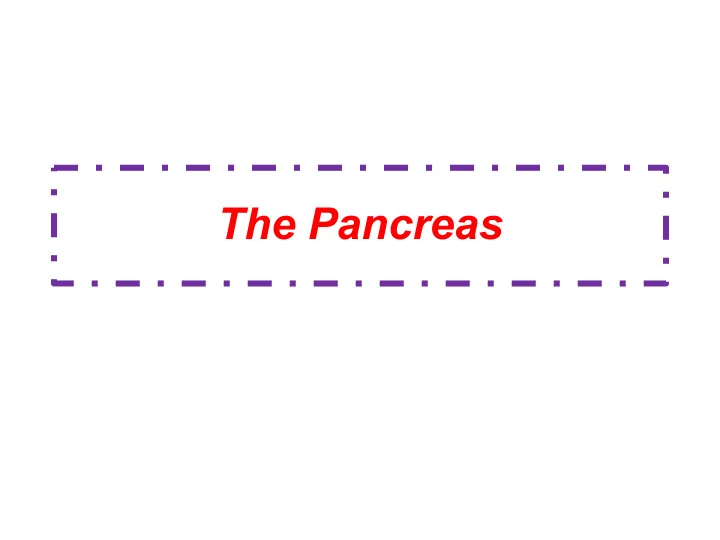

The Pancreas
is a mixed glandular organ (has both endocrine secretions [like the insulin H] and exocrine secretions [Hormones to the digestive system], In humans, it is located in the abdominal cavity behind the stomach. it consist of head,neck,body and tail. **the pancreas as endocrine gland it producing several important hormones, including insulin, glucagon, somatostatin, and pancreatic polypeptide, all of which circulate in the blood.
1-The Insulin Is a peptide hormone produced by beta cells of the pancreatic islets, and it is considered to be the main anabolic hormone of the body. It regulates the metabolism of carbohydrates, fats and protein by promoting the absorption of, Specially the glucose from the blood and facilitate the enterance of it to the cells to be used. In the liver and the skeletal muscle cells the absorbed glucose is converted into either glycogen by glycogenesis or fats (triglycerides) lipogenesis, or, in the case of the liver, into both. Glucose production and secretion by the liver is strongly inhibited by high concentrations of insulin in the blood. Circulating insulin also affects the synthesis of proteins in a wide variety of tissues
*If the body has a problem in Synthesis or secretion insulin or using it effectively to process glucose from food it will lead to abnormal condition called Diabetes Mellitus(DM).
Types Of DM • 1-Type 1 diabetes • Type 2 diabetes occur occur when the when the body can't immune system properly used the insulin mistakenly attaks and that released or dosen't kills beta cell of the make enough insulin. pancreas , no or very this type develope in little insulin is adult. released into the body treatment: depend on as result the suger severity it may be build up in blood managed by plannig instead of being used meals and phyical as energy. this type activities or required developed in children
Action of the insulin In Hyperglycemia
2- the glucagon Glucagon is a peptide hormone, produced by alpha cellof the pancreas. *it works to raise the concentration of glucose and fat in the bloodstream and is considered to be the main catabolic hormone of the body . It is also used as a medication to treat a number of health conditions. Its effect is opposed to that of insulin, which lowers the extracellular glucose
The role of Glucagon • 1-Glucagon generally • 2- Glucagon also elevates the decrees fatty acid concentration of synthesis in adipose glucose in the blood tissue and the liver, • as by promoting well as promoting gluconeogenesis and lipolysis in these tissues glycogenolysis. which causes them to release fatty acids into circulation where they can be catablished to generate energy in tissues such as skeletal muscle when required
In Hypoglycemia
The abnormalities of secretion Abnormally elevated levels of glucagon may be caused by pancreatic tumors, such as glucagonoma, symptoms of which include • necrolytic migratory erythema, ••reduced amino acids,••• and hyperglycemia.
3-Somatostatin Somatostatin, also known as growth hormone-inhibiting hormone (GHIH) or by some other names, is a peptide hormone that regulates the endocrine system and affects neurotransmission and cell proliferation through interaction with G protein-coupled somatostatin receptors and inhibitory of the release of numerous secondary hormones. Somatostatin inhibits insulin and glucagon secretion
The role of somatostatin •1-Somatostatin suppresses the release of gastrointestinal hormones *Gastrin **Cholecystokinin (CCK) ***Secretin ****Motilin *****Vasoactive intestinal peptide (VIP) ******Gastric inhibitory polypeptide (GIP) *******Enteroglucagon
•2-Decrease rate of gastric emptying, and reduces smooth muscle contractions and blood flow within the intestine. 3-Suppresses the release of pancreatic hormones. 4-Suppresses the exocrine secretory action of pancreas.
the abnormal secretion • 1-The excess levels • 2-somatostatin of somatostatin may deficiency have been cause abdominal found in Alzheimer cramps and pain, disease. persistent diarrhea, high blood glucose concentrations, weight loss, and episodic flushing of the skin.
4-Pancreatic polypeptide • is a polypeptide secreted by gama cells •The function of PP 1-is to self-regulate pancreatic secretion activities (endocrine and exocrine) 2- it also has effects on hepatic glycogen levels and gastrointestinal secretions. 3-it is secretion increased after a protein meal, fasting, exercise, and acute hypoglycemia and is reduced by somatostatin and intravenous glucose.
•Thank U for • 👊 👃 • 🌛 🌹
Recommend
More recommend